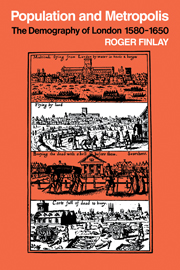Book contents
- Frontmatter
- Contents
- List of tables
- List of figures
- Preface
- 1 Introduction: The magnet of the metropolis
- 2 The accuracy of the London parish registers
- 3 The general growth of population in London
- 4 London social structure in 1638
- 5 The measurement of mortality rates
- 6 The effect of plague on mortality experience
- 7 Marriage and fertility
- 8 Population and metropolis
- Appendix 1 The London bills of mortality
- Appendix 2 Baptisms and burials in sample London parishes
- Appendix 3 Details from the 1638 listing and administrative divisions of London
- Appendix 4 London population in 1631 and houses in 1638 by wards
- References
- Index
8 - Population and metropolis
Published online by Cambridge University Press: 06 July 2010
- Frontmatter
- Contents
- List of tables
- List of figures
- Preface
- 1 Introduction: The magnet of the metropolis
- 2 The accuracy of the London parish registers
- 3 The general growth of population in London
- 4 London social structure in 1638
- 5 The measurement of mortality rates
- 6 The effect of plague on mortality experience
- 7 Marriage and fertility
- 8 Population and metropolis
- Appendix 1 The London bills of mortality
- Appendix 2 Baptisms and burials in sample London parishes
- Appendix 3 Details from the 1638 listing and administrative divisions of London
- Appendix 4 London population in 1631 and houses in 1638 by wards
- References
- Index
Summary
During the late Tudor and early Stuart periods, the most characteristic features of the demographic experience of London was high mortality, due mainly to endemic infections but added to significantly by epidemic plague crises. Diseases spread easily through a large urban population where individuals lived in close proximity to each other. However high fertility may have been, and marital fertility in London was high, the birth rate could not keep pace with the death rate, but migration prevented the population from falling. Economic circumstances in London must have been favourable relative to other places because the capital was growing very rapidly, attracting many more migrants than were necessary to make good the shortfall of births. Because London was so large compared with the country as a whole, accounting for over 5 per cent of the population of England, the connections between the capital and the country through the process of migration were inevitably close. Any interpretation of the population of pre-industrial England must therefore take account of the internal demography of London.
There was a very marked contrast between the pattern of population change in the metropolis and in the remainder of the country. Elsewhere in England, the population was growing, indicating that the birth rate was exceeding the death rate. The chief factor influencing the rate of growth is the incidence of marriage, since marriage controls the formation of new families.
- Type
- Chapter
- Information
- Population and MetropolisThe Demography of London 1580–1650, pp. 151 - 154Publisher: Cambridge University PressPrint publication year: 1981



